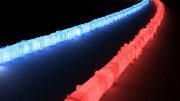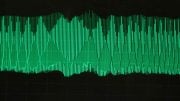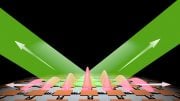
Illustration depicting light propagation without crosstalk in the waveguide array of the developed metamaterial-based optical semiconductor. Credit: KAIST Integrated Metaphotonics Group
Defying conventional wisdom, scientists have discovered a novel coupling mechanism involving leaky mode, previously considered unsuitable for high-density integration in photonic circuits.
This surprising discovery paves the way for dense photonic integration, transforming the potential and scalability of photonic chips in areas such as optical computing quantum communication, light detection and ranging (LiDAR), optical metrology, and biochemical sensing.
In a recent Light Science & Application publication, Sangsik Kim, associate professor of electrical engineering at Korea Advanced Institute of Science and Technology (KAIST), and his students at Texas Tech University demonstrated that an anisotropic leaky wave can achieve zero crosstalk between closely spaced identical waveguides using subwavelength grating (SWG) metamaterials. This counter-intuitive discovery drastically increases the coupling length of transverse-magnetic (TM) mode, which has historically posed challenges due to its low confinement.
This research builds upon their prior studies of SWG metamaterials for reducing optical crosstalk, including control of evanescent wave’s skin-depth and exceptional coupling in anisotropic guided mode. SWGs have recently made significant advances in photonics, enabling various high-performance PIC components. However, integration density challenges remained for the TM mode, which exhibits approximately 100 times larger crosstalk than the transverse-electric (TE) mode, hindering high-density chip integration.
“Our group has been exploring SWGs for dense photonic integration, achieving significant improvements. However, previous approaches were limited to TE polarization only. In a photonic chip, there is another orthogonal polarization TM, which can double the chip capacity and is sometimes more desired than TE, such as in evanescent-field sensing. TM is more difficult to integrate densely than TE because it is typically less confined with a low width-to-height waveguide aspect ratio,” Kim explained.
Initially, the team believed it was impossible to reduce crosstalk using SWGs, as they expected leaky mode to enhance coupling between waveguides. However, they focused on the potentials of anisotropic perturbation with leaky mode, hypothesizing that cross-cancellation might be achievable.
Applying coupled-mode analysis to the modal properties of leaky SWG modes, they uncovered unique anisotropic perturbation with leaky-like mode, resulting in zero crosstalk between closely spaced identical SWG waveguides. Utilizing Floquet boundary simulations, they designed practically implementable SWG waveguides on a standard silicon-on-insulator (SOI) platform that is readily available in the industry, demonstrating remarkable crosstalk suppression and increased coupling lengths by over two orders of magnitude compared to strip waveguides.
This breakthrough also significantly reduces noise levels within PICs, with potential impacts on quantum communication and computing, optical metrology, and biochemical sensing. The researchers further emphasized the broader implications of their work, noting that this novel coupling mechanism could be extended to other integrated photonics platforms and wavelength regimes across visible, mid-infrared, and terahertz beyond the telecommunication band.
This surprising coupling mechanism has expanded the potential for dense photonic integration, defying conventional wisdom and pushing the field’s boundaries. As research continues, the photonics industry will likely see a shift towards denser, lower-noise, and more efficient PIC technologies.
Reference: “Anisotropic leaky-like perturbation with subwavelength gratings enables zero crosstalk” by Md Faiyaz Kabir, Md Borhan Mia, Ishtiaque Ahmed, Nafiz Jaidye, Syed Z. Ahmed and Sangsik Kim, 2 June 2023, Light: Science & Applications.
DOI: 10.1038/s41377-023-01184-5








The more desirable has been mainstay to less desirable in human thought, having a complete roadmap will lead, if a person lends themselves to conventional wisdom a hidden path will stay elusive.
Understanding the coupling mechanism with the framework of topological vortex gravitational field will broaden your thinking.